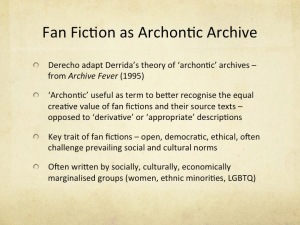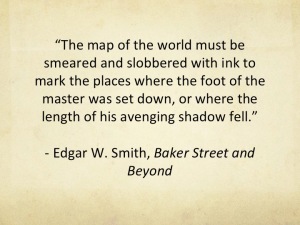My time at the Library of Congress’s Kluge Center is coming to an end. This is sad news. It might also come as a surprise to many (any?) of you reading this blog, given the little time I have devoted to chronicling the relatively rare experience of being a British Research Councils Fellow at the Library of Congress. (I would recommend anyone interested in finding out what it is like to study at the Library’s Kluge Center, or to be a part of the AHRC’s IPS programme, to read the fascinating blogs by Sibylle Machat and Natalie Cox, respectively.
Sighting the beginning of the end of my Kluge time has brought with it the honour of presenting to the distinguished crowd of researchers that make up the Center’s Fellows and staff. To that end, last week I gave a talk on the ways in which fans of Sherlock Holmes (Sherlockians) have used and framed representations of geographical mobility in their fan fictions. I called my paper, ‘Between the Canon and the Commons’ in reference to the work of David Brewer and his notion of fan fictions as a ‘textual commons’, and to suggest that fans’ representations of Holmes and his world have always brought with them elements of Doylean originalism and fan evolution.
Like many academics before me, I made life considerably easier on myself by presenting a paper that I had already given: in this case, I wrote ‘Between the Canon and the Commons’ to be delivered at the Association of American Geographers’ (AAG) annual meeting in Chicago, the week before my Kluge talk.
In this post I will talk a bit about each presentation, show some photos and slides and talk a bit about how my work was received. If you want to read a full-length speaking text of my paper (as yet without footnotes – those will come in time), head over to my page on Academia.edu.
AAG – Chicago 2015
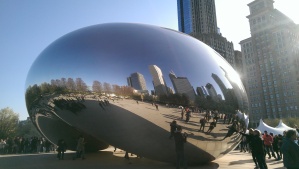
The AAG Annual Meeting is perhaps the largest gathering of geographers (and some others) at any one time. This year, in Chicago, the conference stretched over three venues and six days, involving thousands of attendees, hundreds of panellists and tens of rooms. Yet, the way the conference was set up, with multiple panels at any one time, meant that I only got a sense of the its size and scale at certain moments – in the lobby of the main hotel venue, for instance, or in the nearby bars and restaurants where nearly every customer was wearing the tell-tale green lanyard. Given the small size of each room and the many choices available, the panels themselves were relatively intimate affairs.
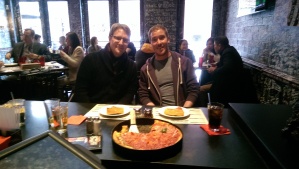
There were around thirty people in the room when I spoke. My paper was part of a panel organised by myself and my supervisor, partly to give us both space in which to contextualise our work and partly to ensure that, at a conference where literary geographers are a rare breed, we would’t get lost on panels with little or no relevance to what we are doing. Phil chaired the first panel, in which I spoke, which was about mobility and circulation as they related to the relationship between literature and the world. Here is a photo of me speaking, and few slides from the presentation:
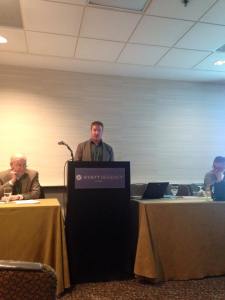
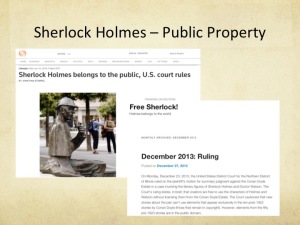
We had a good series of papers, with the first two (my own and Maddy Hamlin’s) considering the formal relationship between literary representations of mobility and meaning in quite different texts; and the latter two (by Perry Carter and Stephen Dreiver) looking at the ways circulation of books or their authors have affected their representations and their impact on the world.
Kluge Center Work-in-Progress
At the Kluge Center I was back on home turf, presenting to a group of academics and the center’s staff,with whom I had discussed my own topic many times. The paper as I gave it was essentially unchanged. Again, here is a photo of me giving the talk, along with a few slides:
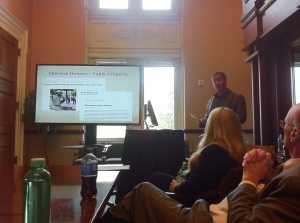
What was really interesting was the difference, in depth and complexity, of the questions I received at the Kluge. Whereas in Chicago I was speaking to a room of geographers, many of whom presumably shared many of my underlying assumptions about the importance of representations of geography in narratives, at the Kluge I was in front of an interdisciplinary audience, whose members’ work differs greatly from my own.
While in Chicago questions focussed on my use of theory, in Washington the questions probed more deeply into my own orientation to the texts and to the ideas of readerly ‘borrowing’ and relationships to originary authors that I was exploring. The different angles from which each listener came gave fresh (and valuable) insights into my work which I will certainly build on.
Perhaps the message to take away here is, even if large, many-panelled conferences seem more prestigious and vital to one’s academic CV, it’s the small, intimate, interdisciplinary places where the real academic growing happens.

